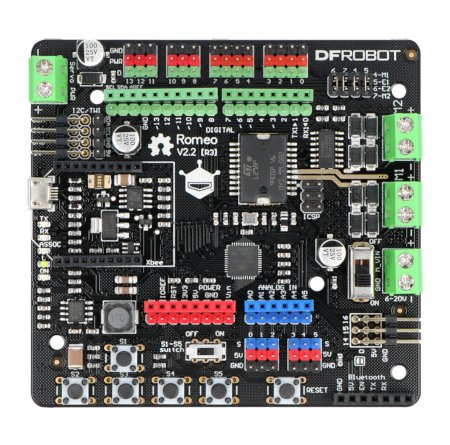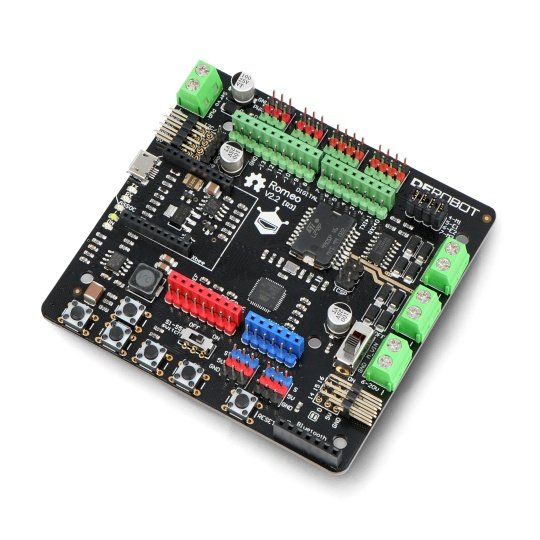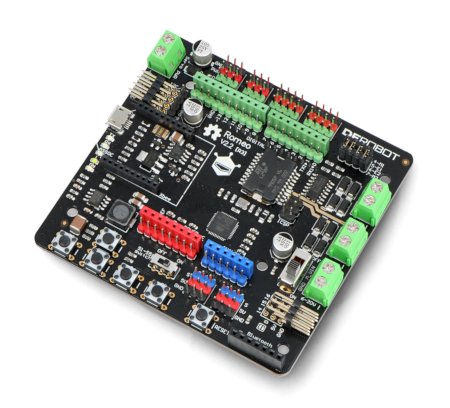Description: Romeo v2 ATmega32u4 - all in one controller - Arduino compatible.
DFRduino is fully compatible with the popularArduino Leonardomodule. It means that it can be programmed throughArduino IDE environmentusing available libraries. Overlays, so calledArduino Shieldwill also work with DFRobot module. Apart from traditional features of the boards, Arduino has a connector forXBee modules, two-channel32V/2A motor controller, power switch and many additional sockets and outputs.
The board contains an ATmega32u4 microcontroller equipped with 20 digital inputs/outputs, 7 of which can be used as PWM outputs (e.g. for controlling motors) and 6 as analogue inputs. The circuit is clocked with a 16MHz clock signal. The module is also equipped with: microUSB connector, screw power supply socket, RESET button and outputs used to connectthe AVR programmer.
The device has many additional features, which are missing from traditional Arduino boards:
- power switch- ON/OFF switch enabling simple disconnection of power supply at any time,
- XBee socket- a connector for direct connection of popular wireless communication modules,
- 5 tact-switch buttons -at your disposal,
- voltage regulator- 5 V with current capacity up to 2 A,
- Two-channel L298 motor controller -allows to control the speed of rotation directions of two DC motors with current consumption up to 2 A.
 DFRobot has introduced colorful connectors for easy identification of the leads:
DFRobot has introduced colorful connectors for easy identification of the leads:
- red- power pins,
- blue- analog pins,
- green- digital pins.
|
In order to start the module, connect the circuit with the computer usingthe microUSB cable andselectthe Arduino LeonardoboardinArduino IDE environment. Detailed product description can be found inthe user guide. |
Power supply
The module can be powered via theUSB cable andan external device, e.g. mains adapter, battery or rechargeable battery. The power supply unit is connected to a standard screw socket. The battery or other source is connected to the POWER connector pins. When connecting to the USB, set the motor power switch to OFF to prevent damage to the unit.
Programming
Creation and installation of softwareenables freeArduino IDEenvironment. Implemented bootloader allows you to upload program directly viaUSB cable.ISCP connector allows to connect externalAVR programmer. Detailed description can be found indocumentation and tutorial.
Specification Romeov2 ATmega32u4
- Power supply voltage: 6 V to 23 V
- Programmable via microUSB interface
- Fully compatible withArduino Leonardo
- Microcontroller: ATmega32u4
- Maximum clock frequency: 16 MHz
- SRAM: 2 kB
- Flash memory: 32 kB (5kB reserved for bootloader)
- EEPROM memory: 1 kB
- Ports I/O: 20
- PWM outputs: 7 - pins 3, 5, 6, 9, 10, 11, 13
- Number of analog inputs: 12 (A/C converter channels) - pins A0-A5 and A6-A11 (on digital outputs 4, 6, 8, 9, 10, 12
- Serial interfaces: UART, SPI, I2C
- External interruptions
- Connector: microUSB socket(USB cablesold separately)
- Soldering of the ISP connector
- Buttons at your disposal: 5
- Connector for direct connection ofXBee communication module
- Two-channel motor controller L298 2A
- Voltage regulator with 5 V/ 2 A output
- Plate dimensions: 89 x 84 x 14 mm
Romeo v2 - Arduino compatible robot controller
The Romeo v2 board is an integrated controller for small mobile robots, fully hardware and software compatible with the popular Arduino platform. A large number of built-in expansion connectors makes it much easier to expand the design with additional sensors or actuators - e.g. servos, LED lighting or sound modules.
What is important, Romeo v2 can be programmed directly through the microUSB port using Arduino ecosystem - the board is based on ATmega32u4 processor and is fully compatible with libraries used on classic Arduino boards. Thanks to the presence of goldpin sockets with spacing and pins layout that represent system slots Arduino UNO, Leonardo or Mega, it is possible to use additional Arduino Shield overlays.
Romeo v2 controller equipment
Romeo v2 ATmega32u4 - all in one controller - compatible with Arduino has a built-in, two-channel DC motor controller, based on the cult L298 (here in SMD version). Through the serial port Romeo can also work with Xbee modules - there is a compatible expansion slot on the PCB, so you can easily enrich the functionality of the robot with wireless connectivity.
The extensive power circuits make it easy to build devices based on the Romeo v2 controller. On the board there is a power switch, a DC/DC converter supplying power to the +5V section (and, through a line stabilizer, also to the +3.3V bus), there is also a circuit that automatically switches the power source in case of a USB cable connection.
Useful links |















































































































































































































































































































































